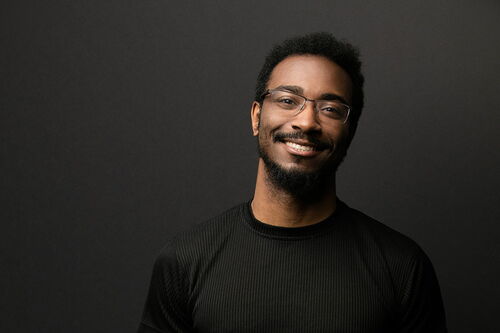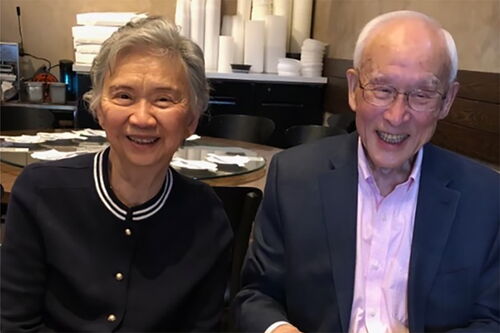Leaving high-tech fingerprints
The large magnet filled an entire corner of the Aberdeen, Scotland, lab. The year was 1979, and this machine was a far cry from the slick magnetic resonance imaging (MRI) machines used in hospitals today. But primitive as it might look, this was a groundbreaking instrument, responsible for creating the first recognizable image of a whole human body.
This device and its innovative “spin warp” imaging technique were developed, in part, by William A. Edelstein (BS, '65, physics), whose many contributions to MRI have earned him the 2008 LAS Alumni Achievement Award. As University of Illinois physics professor Charles Slichter notes, we have “Edelstein fingerprints” all over today’s MRI machines, for Edelstein helped make it possible to take astonishingly detailed images of the inside of the human body.
Edelstein is originally from upstate New York, but his family moved to Northbrook, Ill., when he was 12. Physics ran in the family, with three relatives working in the field, so it came as no surprise when he graduated from U of I with a bachelor’s in physics in 1965.
After following with a master’s and PhD in physics from Harvard in 1974, Edelstein wound up in Scotland at the University of Glasgow, where he worked as a postdoc in a research group trying to detect gravitational waves. He also happened to meet his wife, a Scotswoman by the name of Fiona.
When Edelstein finished the Glasgow postdoc, he began hunting for a new job and says he heard about “this crazy project going on at the University of Aberdeen.” The “crazy project” involved MRI, still a relatively new, unproven technology at the time. So in 1977, the Edelsteins found themselves in remote northeast Scotland, just a stone’s throw from the North Sea.
At the University of Aberdeen, Edelstein became the primary inventor of “spin warp,” an imaging technique that revolutionized the technology and is still used in commercial MRI systems today.
After creating the first recognizable whole-body scan using spin warp, Edelstein returned to the United States in 1980 and went to work for General Electric (GE) at their Corporate Research and Development Center in Schenectady, N.Y. There, he helped to establish an MRI group within the company. Initially, GE was skeptical of MRI, but he says this was understandable, given the unknown nature of the technology.
“You have to give people credit for changing their minds. That’s what’s important,” he says.
The result: By the early 1990s, GE was the leading company in MRI technology and had, by far, the biggest market share. The company was grossing over $1 billion per year from MRI work.
“The business grew as fast as Apple Computer had,” he recalls.
Edelstein made many key contributions to the MRI effort at GE, including important technology that made clinical imaging possible at high magnetic fields. In 1980, the highest-field MRI imaging system being used anywhere featured a 0.3 Tesla (T) magnet. (“Tesla” is a unit of magnetic field strength.) GE’s MRI group brought in a 1.5 T magnet, which most technologists thought would not work for imaging.
But it did. The images of the human head created by the 1.5 T system did not show predicted artifacts, and rapid technical developments at GE quickly led to greatly improved images.
“This development stunned the MRI industry and led directly to GE dominance in the MRI market for an extended period of time,” Edelstein says.
One innovation that was used to create the first 1.5 T whole-body image was the “birdcage” imaging coil, on which Edelstein collaborated. This coil made it possible to create such good images that Edelstein says some people thought the GE team “must have cheated.”
Large coils, such as the birdcage, could be used to image the whole body or head. But Edelstein and the GE team also developed technology to use small imaging coils that could obtain detailed pictures of much smaller parts of the body, such as an eyeball.
In addition, they found a way to use an array of small coils to produce a patchwork of detailed images of small portions of the body, such as parts of the spine; all of the array’s images could then be merged together to get a complete, very detailed picture of the entire spine. Once again, this revolutionary advance was underestimated and the paper describing it was rejected at a key 1988 MRI conference. Undaunted, the GE team still managed to present their work as a poster, and it became the surprise hit of the conference.
“It’s always great when you do something that people are amazed at,” he says.
Edelstein retired from GE in 2001 and continued working as an independent scientist and consultant. In 2007, he was appointed visiting distinguished professor in radiology and radiological sciences at the Johns Hopkins University School of Medicine and moved from Schenectady to Baltimore.
He now has two big interests. First, he is trying to find ways to shorten MRI exams, which typically run 30 to 60 minutes. His goal is to reduce imaging time to 10 minutes and be able to schedule imaging sessions every 15 minutes. This could make MRI exams cheaper and enable more use of MRI.
Edelstein is also looking for ways to reduce the high level of acoustic noise, which forces patients and nearby technicians to use earplugs or other hearing protection. The noise makes the imaging experience unpleasant to patients, interferes with communications, and interferes with functional MRI scans that study brain function.
In other words, Edelstein is not done refining MRI. As Slichter puts it, we are still seeing new Edelstein fingerprints.








